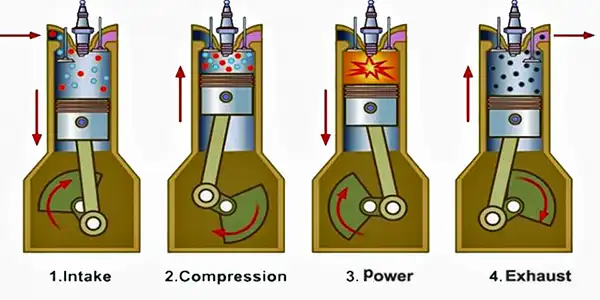How a Four-Stroke Diesel Engine Works
The function of the engine is to convert the thermal energy generated by the combustion of fuel in the cylinder into mechanical energy, thereby outputting power. The above energy conversion process is realized by continuously repeating four continuous processes of "intake-compression-work-exhaust". Each conversion of thermal energy into mechanical energy that takes place in an engine cylinder is called a work cycle.
In one working cycle, the crankshaft rotates for two weeks and reciprocates for four strokes, which is called a four-stroke engine.
1) Intake stroke
Driven by the crankshaft, the piston moves from the top dead center to the bottom dead center. At this point the intake valve opens and the exhaust valve closes. During the downward movement of the piston, the volume above it gradually increases to form a certain degree of vacuum, so fresh air is sucked into the cylinder. When the piston reaches bottom dead center, the intake valve closes, stopping the intake.
2) Compression stroke
Driven by the crankshaft, the piston moves from the bottom dead center to the top dead center. After the intake stroke is completed, both the intake valve and the exhaust valve are closed. During the movement of the piston from the bottom dead center to the top dead center, the volume of the cylinder gradually decreases, the air is compressed into the combustion chamber, and its temperature and pressure rise. high. Because the diesel engine adopts the ignition method of compression ignition, in order to make the diesel engine ignite and burn quickly after being injected into the cylinder, the compression ratio of the diesel engine is large.
3) The power stroke
The Piston moves from the top dead center to the bottom dead center. At this time, the intake valve and exhaust valve are still closed, and the mixture ignites and burns by itself under high temperature and high pressure, and generates a large amount of heat energy, which makes the temperature in the cylinder , The pressure rises sharply, the gas expands rapidly, the high temperature and high pressure gas pushes the piston to move from the top dead center to the bottom dead center, and drives the crankshaft to rotate through the connecting rod to do work, thus realizing the conversion of the chemical energy of the fuel into heat energy, and finally into Mechanical energy. When the piston reaches the bottom dead center, the power stroke ends.
4) Exhaust stroke
The piston moves from bottom dead center to top dead center. During the exhaust stroke, the intake valve closes and the exhaust valve opens. Since the exhaust gas after combustion is still higher than the external atmospheric pressure, the exhaust gas is quickly discharged from the cylinder under the pressure of the gas pressure difference and the upward displacement of the piston.
After the exhaust stroke is over, the crankshaft continues to rotate by relying on the inertia of the flywheel, so that the above four strokes are repeated..
 Track Your Order
Track Your Order




